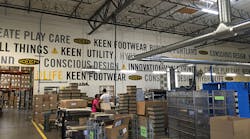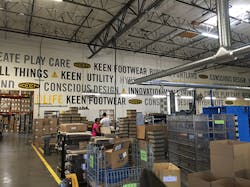I recently traveled to Portland, Oregon to tour the KEEN Utility manufacturing facility with other media types.
The whole KEEN story starts with a hiking sandal. Ten or 11 years ago, you couldn’t find a hiking sandal with toe protection, so KEEN founder Rory Fuerst Sr. brought together a team to innovate a new design that featured toe protection and a wider toe box for comfort. Starting with the innovations the company introduced in the hiking category, it was a natural progression to work shoes and boots.
In 2009, KEEN decided to open a factory in Portland to build its line of high performance work shoes and boots. According to Rory Fuerst Jr., innovation program lead and son of founder Rory Fuerst Sr., they brought in some of the best engineers in footwear manufacturing and everyone told them the same thing: They were out of their minds, and starting up a new manufacturing operation at that time when so many companies were moving operations out of the United States was crazy.
The first few years were tough, but they took what he called “a fearless approach” and told themselves: “This is the road we’re on and we’re going to ride it out.”
Now, all four of Rory Fuerst’s sons are involved in various aspects of the business: design, manufacturing and property management and operations.
In a video they showed us that tells part of the story, Rory Fuerst Jr. said, “It’s cool to sit with your brother at a coffee shop and he says, ‘I made that shoe.’ It’s not like me saying ‘I sketched that shoe or made the prototype.’ He physically made that shoe.”
Everyone at KEEN Utility, from workers on the factory floor to office personnel to the people working in the KEEN Garage footwear store, are proud to be a part of bringing footwear manufacturing back to the United States, and they do it in a safe, bright, modern factory.
While parts of the products may be manufactured in facilities around the world, KEEN is proud of the fact it can say that many of its products are “American built” in Portland and workers in Portland conduct a lot of product testing at the facility as well.
Not Just for the Outdoors
For many people – myself included before this visit – KEEN shoes and boots are associated with outdoor recreational activities like hiking. (Full disclosure: On the recommendation of friends, I purchased and wore a pair of KEEN outdoor sandals on a trip to Thailand last year and I honestly can say that despite miles of walking in 90-degree, high humidity weather, I did not end up with a single blister.)
KEEN Utility is the company’s line of safety footwear for workers, so I had high hopes for them. (Full disclosure: I was given a pair of KEEN Utility work shoes, which I wore to tour the facility, and they were just as comfortable as my sandals.)
Many of the KEEN Utility styles are based on some of the popular outdoor styles, while some are unique to the KEEN Utility line. The company produced 80,000 pairs of shoes the first year, and 420,000 pairs of shoes in 2015. KEEN Utility now is the No. 2 category in the total KEEN brand.
The Portland factory has the capacity to produce 1 million pairs of shoes a year. Currently, they operate one shift, from 6 am to 4:30 pm, Monday through Thursday. Once they reach that 1 million capacity, they will be operating 24/7.
In addition to the factory, the company’s operations in Portland house its headquarters and management teams for KEEN and KEEN Utility, as well as customer service and marketing functions, a product testing department, a couple of design teams and a store.
KEEN Corporate Culture
Because the founder and his four sons all work at the company – with one son leading a design team and one of them managing the factory where the shoes are built – they are involved with the products from start to finish and there’s a lot of pride in that. None of them were given those jobs: they worked their way up through the ranks and learned just about every aspect of the business. And that pride extends to employees, who make it point to say, “I made that shoe” if they see someone wearing a product that is built in Portland.
Employees also are proud of the fact that the company has that Portland vibe… Recycling and protection of the environment practically are a religion in Portland, and by that I don’t mean just recycling plastic water bottles and cardboard.
When the new KEEN headquarters building in the Pearl District in Portland was renovated, they had a bold goal: to send only one dumpster’s worth of material to a landfill. The building is a former turn-of-the-last-century brick building and is five stories tall, 60,000 square feet total. A project of that size normally generates 24 tons of waste.
A local group called the Rebuilding Center came in to deconstruct the building and anything that could be recycled – wood, metal, drywall – was pulled out and sent to local recyclers. Even things like metal grating used for cubical walls by the former tenant was repurposed as part of the railing system for the stairs. Wood from a false ceiling was turned into a boardwalk. Sliding barn doors from a previous, more industrial age were retained. Even the wooden lanes from an old bowling alley that was being torn down were “harvested” by Rory Fuerst and turned into conference tables and countertops in the new space.
The new space features a café that offers employees low-cost lunches made by a chef from fresh and, when possible, local ingredients. There are many areas designated as collaboration spaces scattered throughout the building and the large, open space on the first floor that includes the café and reception area is used for company-wide meetings. Kitchens in the building are open to the rest of the floor and often are used for impromptu meetings and gatherings. Elaborate recycling stations are set up throughout the building. There’s an area in the basement where employees gather to watch movies and television series on their lunch hours.
The building has a "home away from home" vibe, because like many companies hoping to attract Millennials, KEEN not only focuses on the quality of its products, but on the quality of life of its employees and the quality of the environment in which it does business.
The company also believes in giving back to the communities where it works and plays, so it has a grant process called the KEEN Effect, in which it awards $10,000 grants to non-profits around the world that have projects that encourage responsible and innovative uses of outdoor spaces.
As another way to give back, KEEN Utility created a shoe library for the Rebuilding Center, which funds a variety of community projects using the money from its deconstruction services. Working by hand, its crews salvage for reuse up to 85 percent of a building’s major components. Those employees and volunteers often don’t have appropriate personal protective equipment, so the shoe lending library allows them to have the proper footwear.
"Helping those volunteers and staff to work safely gives me a good feeling about my job and about the company," one KEEN Utility employee told me. "It makes me feel like we're doing something special here in Portland."

